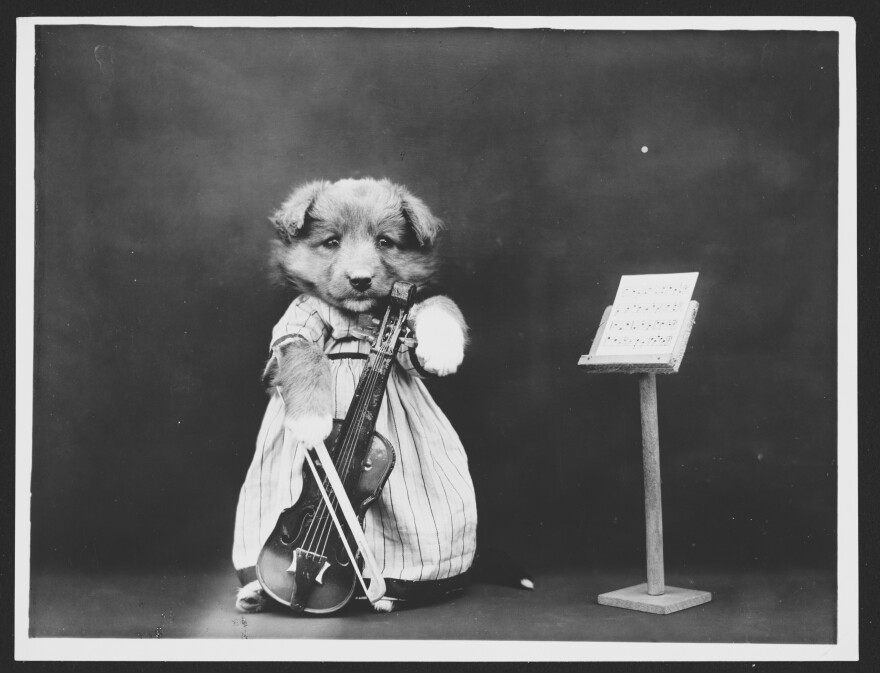Tucked away in the archives of the Library of Congress is a curious set of photos from the first half of the 20th century — animals, mostly kittens and puppies, dressed as people and doing peopley things: baking a cake, holding a cello, getting married.
Of the photos, the Atlantic proclaimed that "their humor and appeal is timeless."
The photographer was Harry Whittier Frees. He has been hailed as "the original LOLcat photographer."
But his life, as it turns out, was not all laughs.
Eureka Moment
Born in Reading, Pa., in the spring of 1879, Harry Frees worked in that state most of his life. For the first half of the 20th century, he was an extremely famous photographer of cutesy animals.
His "eureka moment" came during a family birthday party. Folks were passing around, and trying on, a paper hat. Someone stuck it on the family cat and Frees snapped a picture. A postcard manufacturer liked the shot so much he used it, and the image was an instant success.
Using live models and, reportedly, no photo trickery, the Frees frames became popular illustrations for novelty postcards, books, calendars and magazines. He published many books of his own work. "He rents all models from neighbors, breeders or pet shops," Life magazine explained in a March 1, 1937, profile. "His only assistant is his housekeeper, Mrs. Annie Edelman, who sews all the costumes."
Getting pets in clothes to be still until he could take a photo "was challenging, time-consuming and nerve-wracking," Mary L. Weigley writes in the spring 2014 Pennsylvania Heritage. "It caused Frees so much anxiety that he photographed his furry subjects for only three months a year. To make the situation even more difficult for Frees, only about 30 negatives out of every 100 could be used. Consequently, he needed the remainder of the year to recuperate from exhaustion and formulate new ideas."

The website One More River posts a quote from Frees' own book Animal Land on the Air in which he describes the challenges of getting animals to pose. "Rabbits are the easiest to photograph in costume, but incapable of taking many 'human' parts. Puppies are tractable when rightly understood, but the kitten is the most versatile animal actor, and possesses the greatest variety of appeal. The pig is the most difficult to deal with, but effective on occasion. The best period of young animal models is a short one, being when they are from six to ten weeks of age. An interesting fact is that a kitten's attention is best held through the sense of sight, while that of a puppy is most influenced by sound, and equally readily distracted by it. The native reasoning powers of young animals are, moreover, quite as pronounced as those of the human species, and relatively far surer."
In Isolation
So where does Harry Whittier Frees place in the history of American photography? "I would venture to say that he doesn't even register in photo history or photo criticism circles," says William B. Becker, creator of the online American Museum of Photography. He adds that Frees' work reminded him of another set of anthropomorphic felines, the 1871 stereoscopic-photos "Kitty Series" by John P. Soule.
But Frees was successful, Weigley points out, though he did not enjoy lifelong financial stability. "He never married, devoting his life to his photography and caring for his parents," she writes. "After their deaths in the 1940s, Frees moved to Clearwater, Florida, where he lived in isolation." At some point he was diagnosed with cancer.
He died in March 1953. From an obituary in the St. Petersburg Times: "Despondent over what he regarded as an incurable disease, Harry Whittier Frees, 74, of 709 Senaca Street, took his own life sometime Sunday by turning on the gas stove in the kitchen."
There was no mention of his amazing career.
Follow me @NPRHistoryDept; lead me by writing lweeks@npr.org
Copyright 2021 NPR. To see more, visit https://www.npr.org.



